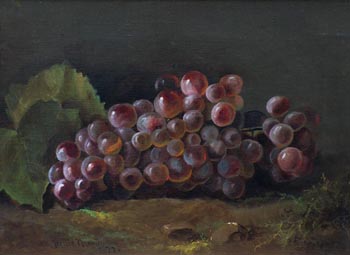Product Description
Dominick & Haff New York Grand Sterling “Grape” Theme Centerpiece Bowl 1883


DOMINICK & HAFF (active 1872-1928) USA
W. H. GLENNY & SONS CO. (retailer, New York City)
Impressive Grape and Vine centerpiece bowl 1883
An exceptional and impressive sterling hand wrought “Grape” theme centerpiece bowl by Dominick and Haff (active 1872-1928) , 1883 and retailed by W. H. Glenny & Sons Co. (retailer, New York City)
Elaborate hand hammered, chased and repousse sterling silver bowl with applied grape branch handles and very deep three dimensional hand repousse grape clusters, leaves and vines, all against a background of graduating honey comb pattern hammer tone marks, original lemon-yellow gold interior, approx. weight: 90 ounces
Marks: Dominick and Haff makers mark incorporating the date 1883, W. H. Glenny Sons & Co. (retailer), 355A, STERLING
H: 6 1/2″ x Dia: 18″
The New York silver firm known today as ‘Dominick & Haff’ originally began with the name ‘William Gale & Son’ in 1862. It went through a series of ownership and name changes to become Dominick & Corning in 1867, Gale and Corning in 1869, Gale Dominick & Haff in 1870 and Dominick & Haff in 1872. In 1929, Dominick & Haff was purchased by the silversmith/ manufacturing company of Reed & Barton of Taunton Massachusetts.
Dominick & Haff New York Grand Sterling “Grape” Theme Centerpiece Bowl 1883
